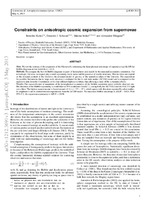| dc.contributor.author | Kalus, Benedict | |
| dc.contributor.author | Schwarz, Dominik J. | |
| dc.contributor.author | Seikel, Marina | |
| dc.contributor.author | Wiegand, Alexander | |
| dc.date.accessioned | 2018-02-06T11:22:59Z | |
| dc.date.available | 2018-02-06T11:22:59Z | |
| dc.date.issued | 2013 | |
| dc.identifier.citation | Kalus, B. et al. (2013). Constraints on anisotropic cosmic expansion from supernovae. Astronomy & Astrophysics, 553: A56 | en_US |
| dc.identifier.issn | 0004-6361 | |
| dc.identifier.uri | http://dx.doi.org/10.1051/0004-6361/201220928 | |
| dc.identifier.uri | http://hdl.handle.net/10566/3477 | |
| dc.description.abstract | AIMS. We test the isotropy of the expansion of the Universe by estimating the hemispherical anisotropy of supernova type Ia (SN Ia) Hubble diagrams at low redshifts (z < 0.2).
METHODS. We compare the best fit Hubble diagrams in pairs of hemispheres and search for the maximal asymmetric orientation. For an isotropic Universe, we expect only a small asymmetry due to noise and the presence of nearby structures. This test does not depend on the assumed content of the Universe, the assumed model of gravity, or the spatial curvature of the Universe. The expectation for possible fluctuations due to large scale structure is evaluated for the Λ cold dark matter (ΛCDM) model and is compared to the supernova data from the Constitution set for four different light curve fitters, thus allowing a study of the systematic effects.
RESULTS. The expected order of magnitude of the hemispherical asymmetry of the Hubble expansion agrees with the observed one. The direction of the Hubble asymmetry is established at 95% confidence level (C.L.) using both, the MLCS2k2 and the SALT II light
curve fitter. The highest expansion rate is found towards (ℓ, b) ≈ (−35◦, −19◦), which agrees with directions reported by other studies.
Its amplitude is not in contradiction to expectations from the ΛCDM model. The measured Hubble anisotropy is ∆H/H ∼ 0.026. With
95% C.L. the expansion asymmetry is ∆H/H < 0.038. | en_US |
| dc.language.iso | en | en_US |
| dc.publisher | Edp Sciences | en_US |
| dc.rights | This is the pre-print version (From arXiv:1212.3691) of the article published online at: http://dx.doi.org/10.1051/0004-6361/201220928 | |
| dc.subject | Isotropy | en_US |
| dc.subject | Expansion of the universe | en_US |
| dc.subject | Hemispherical anisotropy of supernova | en_US |
| dc.subject | Supernova type Ia (SN Ia) | en_US |
| dc.title | Constraints on anisotropic cosmic expansion from supernovae | en_US |
| dc.type | Article | en_US |
| dc.privacy.showsubmitter | FALSE | |
| dc.status.ispeerreviewed | TRUE | |
| dc.description.accreditation | Web of Science | |

